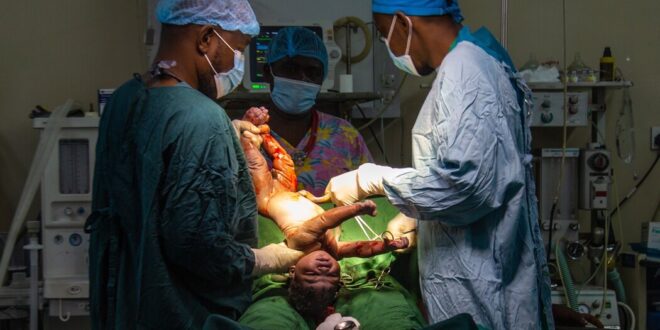![]()
How Long Will This Child Live?
No one can say what the future holds for Crispin Brake, born last month at the Bwaila District Hospital in Malawi. But he and the other babies born in Malawi this year have an expected life span of more than 65 years — an unimaginable outlook just two decades ago, when the nation’s life expectancy was only 44.
People now live 73 years on average globally, more than twice as long as they did a century ago. And today, all around the world, the gap between rich and poor countries continues to close.
![]()
Crispin Brake, a few minutes after delivery.
But the gains are slow, and within some wealthy nations, disparities have lingered or even widened. Global-health experts say that further progress will mean not just lifting up poor nations but also ensuring that no population anywhere is being left behind.
The New York Times Magazine sent photographers to Malawi, Australia and Britain to capture a filament here, a thread there, of the tapestry of health and life expectancy around the globe, including the health workers trying to make it more equal.
![]()
Any further progress on global life expectancy will need to make inroads in sub-Saharan Africa, which continues to significantly lag the rest of the world. But Ethiopia, Malawi and Rwanda are a few of the countries proving that progress is very much attainable, even in the absence of wealth and resources.
Today, thanks to government commitment, international action and community engagement, Malawi, which has the world’s third-lowest gross domestic product per capita, boasts a life expectancy that exceeds those in 30 or so richer countries.
![]()
Glory, 26, in labor at the Kawale Health Center in Lilongwe, the capital of Malawi.
Much of what gives Crispin Brake the prospect of living a long and healthy life has already been determined. His mother received antenatal care and gave birth in a medical facility, where health professionals encouraged skin-to-skin contact and breastfeeding.
![]()
Crispin Brake and his mother, Eunice Soda, 24, the day after his birth.
![]()
New mothers nurture their babies skin to skin at the Bwaila District Hospital in Lilongwe.
![]()
The nursery at the Bwaila District Hospital.
After Crispin goes home, vaccinations, antibiotics, insecticide-treated bed nets and other free health services will help him survive past age 5, the critical point when childhood infections pose a less serious threat.
Many of the health improvements in Malawi can be attributed to government and international investment in primary care, maternal and child health and H.I.V. reduction and treatment.
![]()
Brenda receiving an antenatal checkup at the Kawale Health Center.
In Malawi, many of the most-effective programs tend to be simple and community-based, with villagers trained to provide basic services: monitoring households for malnutrition, giving lessons in family planning.
![]()
Tuma, 22, and her son, who was being checked for malnutrition by a community volunteer in Mutawale village.
![]()
Looking for signs of edema and malnourishment at the Nsaru Health Center in Lilongwe.
The country has also embraced collaborative and innovative opportunities; it is one of three countries to take part in a pilot program for a new malaria vaccine, for example. Coronavirus vaccinations began there in March, before several other countries in the region with deeper pockets and stronger health systems.
![]()
A coronavirus vaccination being given at the Kawale Health Center.
Of course, health is tightly interwoven into a country’s wider socioeconomic fabric. No medicine can make or keep healthy someone who lacks access to clean water, nutritious food, safe housing or a quality education, among many other determinants.
![]()
In Kunkhongo village, Felesiya receives guidance in meal preparation as part of the Scaling Up Nutrition Movement.
![]()
Linda, serving pumpkin tea to her daughter, is able to feed her six children from her garden.
Education, for example: In Malawi, primary-school enrollment reached 91 percent in 2019, while the average in sub-Saharan Africa was closer to 80 percent. Education is crucial to household health. A child born to a literate mother has a 50 percent higher chance of surviving past age 5.
![]()
The antenatal care unit at the Chitedze Health Center in Lilongwe.
![]()
Justina, who is 22 and pregnant with her second child, at the Chitedze Health Center.
Longer life spans tend to come hand and hand with economic development, but this does not mean that everyone in high-income countries is living longer. “Over all, national life expectancy can hide unevenness of those gains,” says Ashish Jha, the dean of the Brown University School of Public Health.
In reality, the health of a country is only as good as the health of its least healthy people. The global-health experts I spoke with, whether or not they were from the United States, all wanted to talk about the gross inequalities and the recent decline in life expectancy in America. What’s concerning is that some of these patterns seen in the United States are present or emerging in a few other high-income countries, if not yet as starkly.
![]()
In Australia, where people over all can expect to live to 83, the Indigenous population — especially those who live in remote areas like the Yarrabah Aboriginal community in rural Queensland — have long faced comparatively worse health outcomes.
![]()
Jamahl Creed, 30, cooling off after work in Yarrabah.
![]()
A home in Yarrabah. There is a housing crisis in Indigenous communities across Australia.
![]()
Royston Dabah and Iris Davidson outside their home in Yarrabah – a fishing shack.
Life expectancies in the two Indigenous groups — Aboriginal people, which are the majority, and Torres Strait Islander people — lag those of non-Indigenous Australians by more than eight years, and their infants and toddlers die at twice the rate.
Rheumatic heart disease, an illness that’s often rooted in poverty and reflects a lack of access to basic health services, occurs almost solely among young Indigenous people in Australia, spotlighting the country’s extreme health disparities.
![]()
Finette Mundraby, 33, at home in Yarrabah with her youngest daughter, Reannan Kynuna, 3. Mundraby has rheumatic heart disease.
![]()
John Gordon, 13, has rheumatic heart disease and has had surgery to replace his heart valves.
The differences in mortality are mostly a result of cardiovascular disease, diabetes and cancer. But mental health presents a harrowing problem too: Indigenous Australians die of suicide at twice the rate of their non-Indigenous counterparts — and among adolescents, that disparity nearly doubles.
![]()
James Noble, 50, at home in Yarrabah. He lost his leg to complications from a blood clot and also has rheumatic heart disease.
![]()
Maxwell Sexton, a 17-year-old who has rheumatic heart disease and Type 1 diabetes, at his cousin’s home in Yarrabah.
Many Indigenous communities in Australia have taken over their own health care, through more than 300 primary-care clinics that are designed to focus on their culture and values.
![]()
Jimmy Perry, 68, being seen by a health worker at the Gurriny Yealamucka health care center in Yarrabah.
![]()
Mina Andrews, 67, undergoing kidney dialysis at the primary-care clinic in Yarrabah. Renal disease is a major cause of illness and death among Indigenous Australians.
The national Closing the Gap initiative launched in 2007 with the aim of eliminating the difference in life expectancy between Indigenous and non-Indigenous Australians within a single generation. But the gap has narrowed by only three or so years over the last decade, meaning the goal is unlikely to be met.
![]()
In Britain, the increase in overall life expectancy has nearly stalled. And just as in the United States — where, in Ashish Jha’s words, “your ZIP code is your destiny” — the disparities can vary starkly by neighborhood.
![]()
The Legion of Mary Wayside Club, in the center of Glasgow, offers meals to the homeless and needy.
![]()
National Health Service workers visiting Michael Wood, 71, who is diabetic and insulin-dependent, in Blackpool, England.
![]()
Shannon D., 20, injecting heroin in a private, volunteer-run safe space for drug users in Glasgow.
The residents of Westminster, England, can expect to live roughly a decade longer than those in Glasgow, which is the place with the shortest life span in the four British nations — “the Glasgow effect,” as it has been termed. A similar disparity is evident when Westminster is compared with Blackpool, one of the most deprived areas in England itself.
![]()
Connie Morrison, 97, and a nurse at Loveday Chelsea Court Place, a luxury memory-care home in London.
![]()
Roy Dantzic, 76, training with Louise Appel at his home in Westminster.
![]()
Lalla Hurst, 92, after a dance-movement psychotherapy session at Loveday Chelsea Court Place.
Michael Marmot, the director of the University College London’s Institute of Health Equity, put out a report a decade ago on the country’s health inequalities. “England is faltering,” he wrote last year.
Throughout Britain, mortality rates are increasing among some of the most socioeconomically disadvantaged areas, demonstrating that inequalities in health mirror the inequalities in society.
![]()
Mick Fleming, 55, a pastor who is in recovery from drug and alcohol use, visiting with Kayleigh Hacking, 34, and her partner in Burnley, England.
![]()
Jamie Smith, 44, lives in a tent along the Blackpool promenade.
The economists Anne Case and Angus Deaton have noted that in the United States, working-age white people without college degrees have faced an increase in mortality rates over the last several years. One large factor is “deaths of despair” — from drugs, alcohol, suicide — which are now being seen in other groups as well.
![]()
Robert Griffiths, 44, injecting cocaine in Glasgow. He has been using drugs since he was 13.
![]()
Sylvia McGrath, 66, outside her home in Glasgow. She has emphysema and lost both parents and a brother to the disease.
![]()
Eileen Hopkins suffered from many illnesses. She died at 67, a few days after this picture was taken.
“Put simply,” Michael Marmot warns, “if health has stopped improving, it is a sign that society has stopped improving.”
![]()
Fleming offering a blessing to Patrick Marren, 56, a drug user in Burnley.
![]()
The Amazing Graze Soup Kitchen in Blackpool provides hot meals and food parcels to those in need.
![]()
A nurse with the National Health Service tending to Doris Winston, 75, who is diabetic and housebound, in Blackpool.
As these photographs show, extending life spans doesn’t require cutting-edge technologies or advanced, specialized care. In certain places, the greatest returns on health investment come from improving births, preventing infections in children and providing other basic medical services.
But even in the wealthiest nations, which enjoy high average life expectancies, the numbers can disguise how particular segments of the population are being left behind.
Above all, these photographs should be cause for inspiration as well as vigilance. They show how possible it is to drastically expand the promise of long life — but also how exquisitely fragile those extra years can be.
![]()
An extended family in Glasgow.
Helen Ouyang is a physician, writer and assistant professor at Columbia University. She’s been a finalist for the National Magazine Award. Lynsey Addario is an American photojournalist and a regular contributor to the magazine. She is a recipient of a MacArthur Fellowship, a Pulitzer Prize winner and the author of the New York Times best-selling memoir “It’s What I Do: A Photographer’s Life of Love and War.” Yagazie Emezi is a Nigerian artist and self-taught photojournalist focused on stories surrounding African women and their health, sexuality, education and human rights. Morganna Magee is a documentary photographer from Australia. She is currently working on projects exploring the intersection of memory, grief and photography.
Additional design and development by Jacky Myint.
 Top Naija News: Nigerian News, Breaking News Nigeria and World News Top Naija News is a daily news publication in Nigeria, delivering the latest breaking news in Nigeria and around the world.
Top Naija News: Nigerian News, Breaking News Nigeria and World News Top Naija News is a daily news publication in Nigeria, delivering the latest breaking news in Nigeria and around the world.




